Showing Spotlights 825 - 832 of 2879 in category All (newest first):
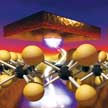 In trying to bring brain-like (neuromorphic) computing closer to reality, researchers have been working on the development of memory resistors, or memristors, which are resistors in a circuit that 'remember' their state even if you lose power. Now, scientists have discovered non-volatile memory effect in atomically thin 2D materials such as MoS2. This effect is similar to memristors or RRAM in metal oxide materials. These devices can be collectively labeled atomristor, in essence, memristor effect in atomically thin nanomaterials or atomic sheets.
In trying to bring brain-like (neuromorphic) computing closer to reality, researchers have been working on the development of memory resistors, or memristors, which are resistors in a circuit that 'remember' their state even if you lose power. Now, scientists have discovered non-volatile memory effect in atomically thin 2D materials such as MoS2. This effect is similar to memristors or RRAM in metal oxide materials. These devices can be collectively labeled atomristor, in essence, memristor effect in atomically thin nanomaterials or atomic sheets.
Jan 2nd, 2018
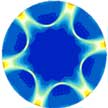 Topological superconductivity is an interesting state of matter, partly because it is associated with quasiparticle excitations, which are Majorana fermions, i.e. particles that are their own antiparticles, obeying non-Abelian statistics and therefore being of prime interest for topological quantum computing. A well-known example are chiral superconductors with px�ipy-wave pairing of electrons into a condensate of Cooper pairs, the carriers of superconductivity. Researchers suggest to consider mesoscopic samples, confined to the energetically favorable domain size, as a suitable platform to verify and potentially control the chiral domains.
Topological superconductivity is an interesting state of matter, partly because it is associated with quasiparticle excitations, which are Majorana fermions, i.e. particles that are their own antiparticles, obeying non-Abelian statistics and therefore being of prime interest for topological quantum computing. A well-known example are chiral superconductors with px�ipy-wave pairing of electrons into a condensate of Cooper pairs, the carriers of superconductivity. Researchers suggest to consider mesoscopic samples, confined to the energetically favorable domain size, as a suitable platform to verify and potentially control the chiral domains.
Dec 27th, 2017
 Crossing the blood-brain barrier (BBB) is the object of intensive research in nanotechnology and biomedicine for developing new therapies against brain cancer and for the treatment of neurodegenerative diseases. For this reason, it is extremely important to develop realistic models of the BBB, which mimic as most accurately as possible the in vivo environment. The development of high-resolution 3D-printing technologies has now enabled researchers to develop a realistic 3D bio-hybrid microfluidic model of BBB inspired by the in vivo neurovasculature.
Crossing the blood-brain barrier (BBB) is the object of intensive research in nanotechnology and biomedicine for developing new therapies against brain cancer and for the treatment of neurodegenerative diseases. For this reason, it is extremely important to develop realistic models of the BBB, which mimic as most accurately as possible the in vivo environment. The development of high-resolution 3D-printing technologies has now enabled researchers to develop a realistic 3D bio-hybrid microfluidic model of BBB inspired by the in vivo neurovasculature.
Dec 21st, 2017
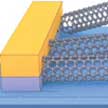 The detection of carbon monoxide (CO) in the air is a vital issue, as CO is a highly toxic gas and an environmental pollutant. Carbon monoxide is poisonous because it blocks the binding site for oxygen in hemoglobin. It is exactly this principle - a porphyrin ring with a central iron or cobalt atom that the poisonous gas attaches to - that can be used to implement sensors to warn against carbon monoxide. While carbon monoxide sensors have been extensively researched and commercialized, none make use of a molecule that can be voltage-activated using a newly reported method.
The detection of carbon monoxide (CO) in the air is a vital issue, as CO is a highly toxic gas and an environmental pollutant. Carbon monoxide is poisonous because it blocks the binding site for oxygen in hemoglobin. It is exactly this principle - a porphyrin ring with a central iron or cobalt atom that the poisonous gas attaches to - that can be used to implement sensors to warn against carbon monoxide. While carbon monoxide sensors have been extensively researched and commercialized, none make use of a molecule that can be voltage-activated using a newly reported method.
Dec 20th, 2017
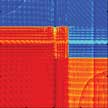 Valleytronics is an emerging field exploiting electron's valley degree of freedom for device applications. This novel concept is based on utilizing the wave quantum number of an electron in a crystalline material. One major challenge in valleytronic-based electronics is the lack of all-electrical-controlled valley filter, a device that produces valley-polarized current via electrical controlling knob and serves as a fundamental building block of valleytronics. Researchers now have proposed a versatile all-electric-controlled valley filter and demonstrate, for the first time, a concrete working design of valleytronic-based logic gate capable of performing all 16 types of Boolean logics.
Valleytronics is an emerging field exploiting electron's valley degree of freedom for device applications. This novel concept is based on utilizing the wave quantum number of an electron in a crystalline material. One major challenge in valleytronic-based electronics is the lack of all-electrical-controlled valley filter, a device that produces valley-polarized current via electrical controlling knob and serves as a fundamental building block of valleytronics. Researchers now have proposed a versatile all-electric-controlled valley filter and demonstrate, for the first time, a concrete working design of valleytronic-based logic gate capable of performing all 16 types of Boolean logics.
Dec 19th, 2017
 Researchers have discovered that ices of simple organic molecules such as alcohols and nonane (main component of diesel) can be nanopatterned by a focused electron beam. The entire 3D lithography process takes place in a single vacuum instrument and avoids exposing users to chemicals and the need for cleanrooms. With organic ice resist (OIR) technology, nanolithography can be made accessible to more scientists. The short-term implication of this work is to provide researchers with a new nanoscale 3D printing technology. The long-term implications might have a revolutionary impact on semiconductor production and computing.
Researchers have discovered that ices of simple organic molecules such as alcohols and nonane (main component of diesel) can be nanopatterned by a focused electron beam. The entire 3D lithography process takes place in a single vacuum instrument and avoids exposing users to chemicals and the need for cleanrooms. With organic ice resist (OIR) technology, nanolithography can be made accessible to more scientists. The short-term implication of this work is to provide researchers with a new nanoscale 3D printing technology. The long-term implications might have a revolutionary impact on semiconductor production and computing.
Dec 14th, 2017
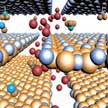 Motived by the large number of non-layered materials, e.g. transition metal oxides, which hold great promise in battery applications, scientists aim to extend the concept of nanofluidic channels into intrinsically non-layered materials and improve their electrochemical properties. In a new study, researchers have developed a Co3O4-based two-dimensional nano-architecture possessing nanofluidic channels with specially designed interlayer characteristics for fast lithium ion transport, leading to exceptional performance in lithium ion batteries ever reported for this material.
Motived by the large number of non-layered materials, e.g. transition metal oxides, which hold great promise in battery applications, scientists aim to extend the concept of nanofluidic channels into intrinsically non-layered materials and improve their electrochemical properties. In a new study, researchers have developed a Co3O4-based two-dimensional nano-architecture possessing nanofluidic channels with specially designed interlayer characteristics for fast lithium ion transport, leading to exceptional performance in lithium ion batteries ever reported for this material.
Dec 8th, 2017
 So far, most of the developed self-powered piezoelectric devices are rigid or have limited lateral stretchability and could not be used to harvest energy from lateral strain, which greatly limits their applications on large strain deformation. In new work, researchers have successfully fabricated a piezoelectric nanocomposite device with good transparency, high stretchability, and self-powered sensing characteristics. Attached to the human body, it can harvest biomechanical energy and monitor physiological signals.
So far, most of the developed self-powered piezoelectric devices are rigid or have limited lateral stretchability and could not be used to harvest energy from lateral strain, which greatly limits their applications on large strain deformation. In new work, researchers have successfully fabricated a piezoelectric nanocomposite device with good transparency, high stretchability, and self-powered sensing characteristics. Attached to the human body, it can harvest biomechanical energy and monitor physiological signals.
Dec 4th, 2017
 In trying to bring brain-like (neuromorphic) computing closer to reality, researchers have been working on the development of memory resistors, or memristors, which are resistors in a circuit that 'remember' their state even if you lose power. Now, scientists have discovered non-volatile memory effect in atomically thin 2D materials such as MoS2. This effect is similar to memristors or RRAM in metal oxide materials. These devices can be collectively labeled atomristor, in essence, memristor effect in atomically thin nanomaterials or atomic sheets.
In trying to bring brain-like (neuromorphic) computing closer to reality, researchers have been working on the development of memory resistors, or memristors, which are resistors in a circuit that 'remember' their state even if you lose power. Now, scientists have discovered non-volatile memory effect in atomically thin 2D materials such as MoS2. This effect is similar to memristors or RRAM in metal oxide materials. These devices can be collectively labeled atomristor, in essence, memristor effect in atomically thin nanomaterials or atomic sheets.
 Subscribe to our Nanotechnology Spotlight feed
Subscribe to our Nanotechnology Spotlight feed





